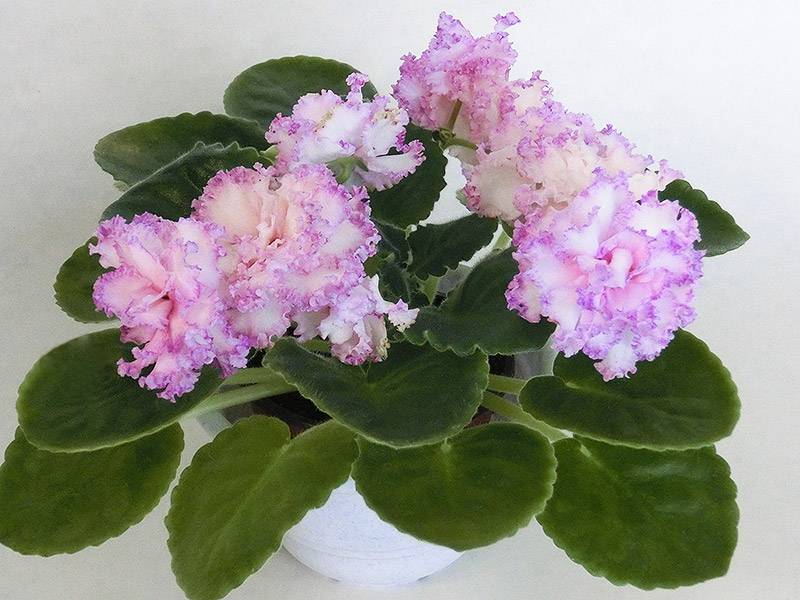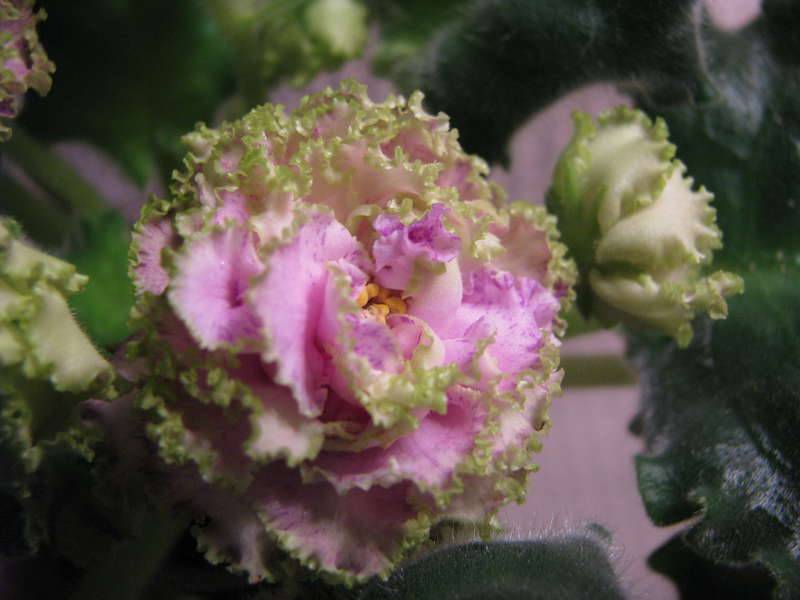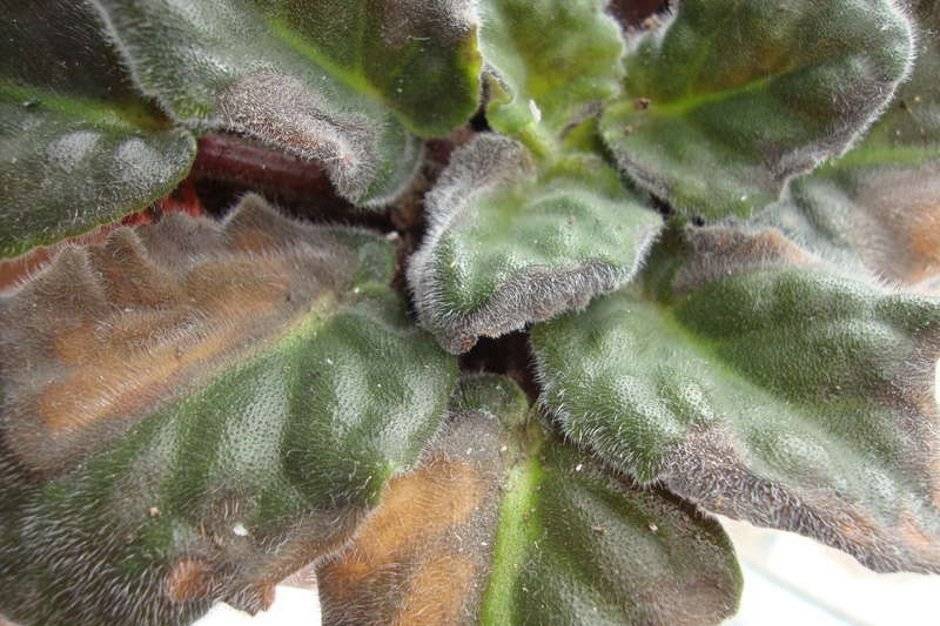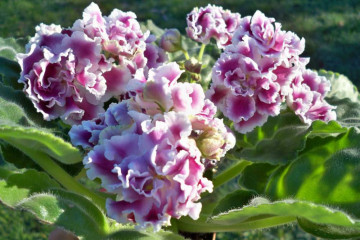Violet Fairy - description and characteristics of the variety
Content:
Among the many varieties of violets, the Fairy variety stands out for its beauty. The plant has slightly carved leaves and double flowers with corrugated edges. The Fairy looks especially regal next to violets, which have simple petals, for example, with the violet Actress. Read on for information on growing Fairies at home.
What does a violet Fairy look like
On one flower arrow of the Fairy, 1-2 buds are formed. The flowers are large, corrugated. A pleasant aroma emanates from them.
The bush reaches a height of 15 centimeters. It consists of a rosette with large green leaves, from the middle of which arrows with flowers grow. In the description of the culture, it is indicated that the base of the petals is white, the middle is colored pink, the edges are first pale green, then the bronze palette.
Saintpaulia Fairy belongs to the Gesneriev family. Under natural conditions, the culture prefers to settle in slightly shaded places. She can be found near waterfalls, where she feels good in the conditions of water dust.
The date of birth of Saintpaulia (scientific name for violets) is 1893. The discoverer of this plant species is Baron Walter von Saint-Paul.
If we talk specifically about the Fairy, then she was bred by the breeder Tatyana Dadoyan in 2012. The variety was immediately presented to the Moscow public, and won rave reviews from experts and flower lovers.
Care features
So that Saintpaulia Fairy does not lose its decorative appearance, it must be properly cared for throughout the year. This will be discussed in detail below.
Temperature
Saintpaulia prefers to grow at an air temperature of 20-25 ° C. In winter, it should not fall below 16 ° C.
Lighting
The violet is placed in a well-lit or slightly shaded place. It should be borne in mind that the midday sun should not burn the sheet plates.
Saintpaulia develops well on the south, west and east windows. Arrange flower pots so that plant leaves do not touch.
Watering
Water for irrigation is used warm, settled. The soil is irrigated after the upper layer dries up. After 10-15 minutes, the excess water is poured from the pan. With excessive moisture in the soil, the bushes can be affected by putrefactive microorganisms.
There must be drainage holes in the pot. Some growers practice bottom watering of violets: water is poured into a pan, and when the top layer of earth gets wet, excess liquid is removed.
Spraying
Spraying is not required for the leaf plates. But, if they are covered with a layer of dust, you can arrange a shower for the violet. At the same time, at the base, the plant is carefully wrapped in foil so that water does not get inside the pot.
Humidity
The room where the violets are located must have a humidity of at least 50%. To increase it, containers with water are placed near the pots with Saintpaulias.
Another way to increase humidity is to place the flower container in a pallet of moistened sand.
Priming
The substrate for the Fairy violet is selected loose, breathable.In a flower shop, you can buy soil for Saintpaulias, or prepare it yourself from the following components:
- leafy and sod land;
- peat;
- coniferous litter;
- sand;
- perlite.
To disinfect the earth, increase acidity, air permeability, sphagnum moss can be added to it.
Top dressing
From early spring to late autumn, the violet is fed every 2 weeks.
Complex mineral fertilizers are used for this. In winter, 1 top dressing per month is enough. Fertilize the bushes after watering the land with plain water. This condition must be met to prevent scalding of the root system with salts.
When and how it blooms
Provided the violet is provided with conditions close to natural, it can bloom most of the year. The buds begin to grow profusely in early spring. Flowering continues for 8-9 months.
The petals of the violet Fairy of the Dadoyan selection are white at the base. Their edges are pink, corrugated. Some flowers are bordered with a bronze stripe.
How the violet Fairy reproduces
At home, the culture is propagated by leaf and dividing the bush. Seeds are usually bred in nurseries. Why is this method not used by flower growers? It is long-term and with this method maternal qualities may not be transmitted.
Sheet
For breeding, sheets are chosen from the middle tier: the lower ones are too old and weakened, the upper ones are young, not gaining strength. The procedure for breeding violets is performed as follows:
- With a sharp knife, cut off a leaf with a handle.
- Place it in a glass of water for rooting.
- When roots appear on the cut of the cutting, it is planted in a small pot with loose soil.
- Water, cover the container with a film with holes made in it.
In greenhouse conditions, the leaf will quickly take root, grow up children, who are placed in separate containers after about a month.
By dividing the bush
Young rosettes grow over time at the base of the violet. They are carefully separated from the mother plant and planted in separate pots. If there are few roots on the rosettes, remove a few lower leaves.
The containers are covered with foil, placed in a warm, bright place.
Transplant after purchase and during reproduction
Immediately after purchase, the violet is kept separately from other flowers. This is necessary in order to identify possible plant pests. If none are found, the violet is transplanted as follows:
- pick up a pot in a volume slightly larger than the previous one;
- drainage is laid out on the bottom;
- pour the earth, set a bush in the middle;
- cover it with a substrate along the root collar;
- lightly tamp the soil, water the flower.
Violets are also transplanted during reproduction by dividing the bush. After the separation of young rosettes, the mother plant is planted in the same pot, but a new substrate is added.
Possible growing problems
With improper care, a decrease in immunity, the violet can lose its decorative appearance.
Leaf problems
The edges of the leaves may begin to turn yellow and dry out. The likely cause is the appearance of rot due to excessive watering.
- If a mosaic appears on the leaf plates, this means that too much bright light gets on the bush, or there is a lack of trace elements in the soil.
- When the edge of the leaf turns dark, it is likely that the culture is affected by a fungal disease.
Diseases
Fairy is a violet that is periodically affected by powdery mildew, bacteriosis, rust, root and stem rot. Pathogenic microorganisms get on the bushes when planted in contaminated soil, pass from other plants. Rot is formed when the substrate is over-watered.
To prevent diseases of violets, it is necessary to carry out preventive measures.First of all, after the purchase, arrange a quarantine for the flowers, do not use soil from other plants, water moderately, protect from drafts.
Pests
The Fairy violet can be attacked by sucking and gnawing pests. Aphids, thrips, scale insects extract juice from the leaves. They eat the ground and underground parts of weevils, ticks, nematodes. To get rid of insects, the bushes are sprayed with disinfectants 2-3 times with an interval of 10 days.
A sign that the plant is overpowered by worms is the presence of white fluff at the base. To rid the violet of pests, it must be rinsed with water, sprayed with a chemical, and transplanted into a new soil.
In case of damage by nematodes, the same actions are performed, but the damaged roots are removed first.
Signs of improper care
With improper care, the following happens:
- If the light is too bright, the leaves fall down.
- If the pot is too large, the violet does not bloom, but builds up young rosettes.
- With an excess of nitrogen in the soil, flowering does not occur.
- In hot weather and long daylight hours, the leaf plates are rolled inward.
- If the violets do not have enough light, the leaves become small.
- If the root system rots, the flower is overfilled with water.
The Fairy violet is a spectacular houseplant. This culture is capricious, but if you fulfill its requirements correctly, it will delight you with flowering 8-9 months a year.





















